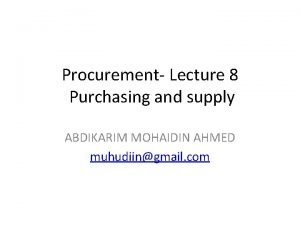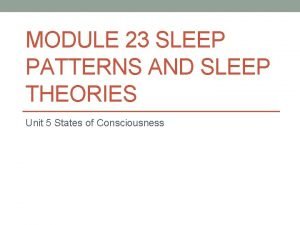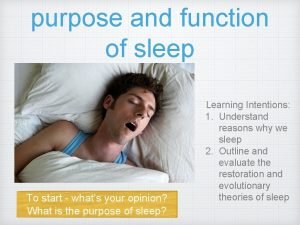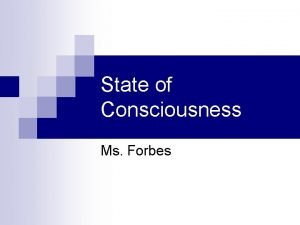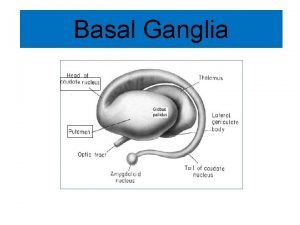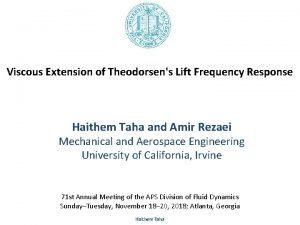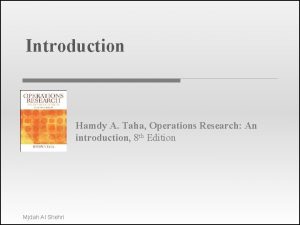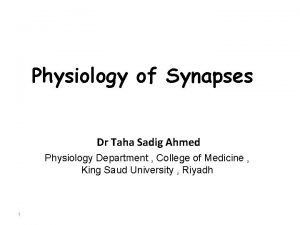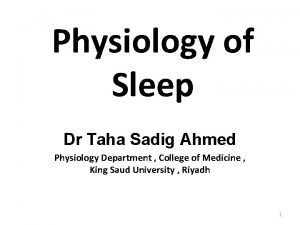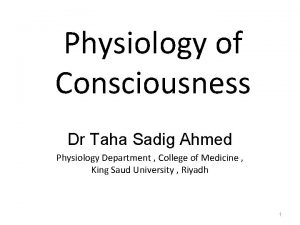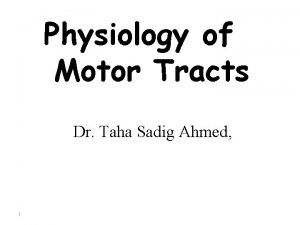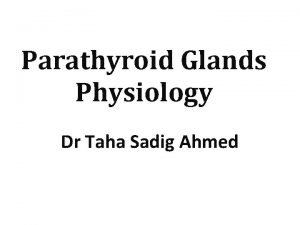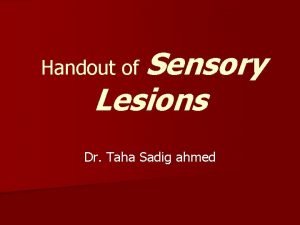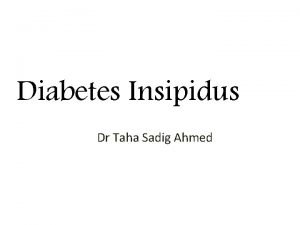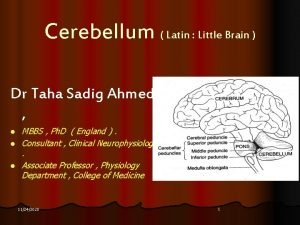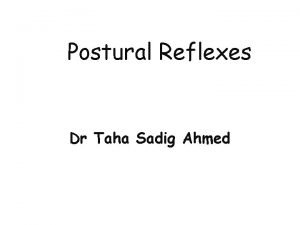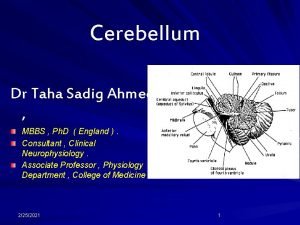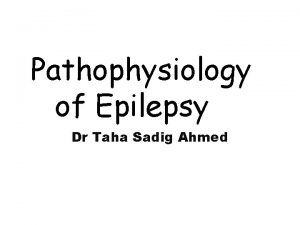Physiology of Sleep Dr Taha Sadig Ahmed Physiology














- Slides: 14

Physiology of Sleep Dr Taha Sadig Ahmed Physiology Department , College of Medicine , King Saud University , Riyadh References : Guyton and Ganong Textbooks of Medical Physiology 1

Objectives • At the end of this lecture the student should be able to : • (1) explain the difference between sleep and coma. • (2) define what is meant by NREM ( non-rapid eye movement, SWS ) and REM ( rapid eye movement ) sleep. • (3) describe how NREM and REM sleep are distributed during a normal night sleep in the average adult human • (4) describe the behavioral and autonomic features associated with NREM and REM sleep. • (5) describe how the EEG , as a physiological tool , is being used to delineate in which stage of sleep ( or wakefulness ) a person is. • (6) appreciate how the total sleep duration and different sleep stages vary with different ages in normal humans. • (7) describe the current theories about the neural basis of sleep.

• Q : What is the difference between sleep and coma ? • Sleep is defined as unconsciousness from which the person can be aroused by sensory stimuli. • If we do an EEG ( electroencephalogram ) , his EEG will show various waves that are characteristic of different sleep stage. • Coma, on the other hand , is a state of loss of consciousness ( LOC) from which the person cannot be aroused , • If we do EEG in a comatose person , the EEG will be dominated by slow waves. 3

Q : What are the types of sleep ? • Depending on EEG criteria , during each night we go through 2 types of sleep that alternate with each other. They are : • (1) SWS (Slow-Wave Sleep), • because in this type of sleep EEG waves are generally of low frequency. • It is also called Non-Rapid Eye Movement (NREM) sleep because , unlike the other type of sleep , it is not associated with rapid eye movements. • (2) REM sleep (Rapid Eye Movement ), • because in this type of sleep the person makes rapid movements by his eyes , in spite of the fact that he is sleeping. 4

Distribution of Sleep Stages • While SWS occupies most of the total night sleep time ( around 75 -80 n%) , it is nterrupted by intervening REM sleep periods , approximately every 90 minutes. • In a typical night of sleep , a young adult (1) first enters NREM sleep , passes through stages 1 , 2 , 3 and 4 SWS , and then, 60 -100 minutes from sleep onset , • (3) goes into the first REM sleep episode • This cycle is repeated at intervals of about 90 minutes throughout the 8 hours or so of a night sleep. • Therefore , there are 4 -6 sleep cycles per night ( and 4 -6 REM periods per night) • As the night goes on there is progressive reduction in stages 3 and 4 sleep and a progressive increase in REM sleep. 6 REM sleep periods are shown in red 11/9/2020 In a young adult SWS occupies 75 -80% of a night sleep time , & REM sleep occupies 20 -25 % of the sleep time

6 yrs REM sleep occupies 80 % of total sleep time 10 yrs in premature infants , and 50 % in full-term 21 yrs neonates ( new born 30 yrs baies). l Thereafter , the 69 yrs proportion of REM sleep falls rapidly and plateaus at about 25% until it falls further in old age. l Children have more total sleep time and stage 4 sleep than adults. l 7 11/9/2020

• • Non-Rem ( NREM) Sleep ; (also called Slow-Wave Sleep , SWS ) NREM sleep is an exceedingly restful type of sleep It is typically exemplified in the first hour of sleep hat follows a prolonged period of sleep deprivation It is associated with (1) decrease in peripheral vascular resistance ( there is 10 - 30 % decreases in BP ) , (2) decrease in respiratory rate, (3) decrease in BMR ( Basal Metabolic Rate) , & (4) increased Growth Hormone Secretion Sometimes dreams , even nightmares , occur during SWS sleep. However , dreams are more characteristic of REM sleep 8

REM Sleep ( Paradoxical Sleep ) • In a normal night of sleep, episodes of REM sleep lasting 5 to 30 minutes usually appear on the average every 90 minutes. • REM sleep is not as restful as SWS. • When the person is extremely sleepy, each bout of REM sleep is short, and it may even be absent. • Conversely, as the person becomes more rested through the night, the durations of the REM bouts increase. • There are several important characteristics of REM sleep: (1) There are rapid eye movements , this is usually associated with dreaming. (2) Muscle tone throughout the body ( except eye muscles ) is exceedingly depressed ( as shown by decreased EMG activity) hypotonia.

(3) Despite the extreme inhibition of the peripheral muscles ( as shown by decreased EMG activity, irregular , active bodily muscle movements do occur. (4) Heart rate ( HR ) and respiratory rate ( RR) usually become irregular + BP fluctuations may occur which is characteristic of the dream state (5) The person is more difficult to arouse by sensory stimuli than during NREM sleep , and yet people usually awaken spontaneously in the morning during an episode of REM sleep ( and frequently remember bits & pieces of the dream ). (6) The brain is highly active in REM sleep, and overall brain metabolism may be increased as much as 20 %. (7) The EEG shows a pattern of brain waves somewhat similar to those that occur during wakefulness ( low amplitude mixed frequency activity , with Beta waves mainly ). 10

• Therefore , it is not surprising that REM sleep is also called paradoxical sleep : the paradox being that the person is asleep although he looks awake • The brain is highly active in REM sleep, and overall brain metabolism may be increased as much as 20 % • In summary, REM sleep is a type of sleep in which the brain is quite active , but this brain . • (1) is not aware cut off the external world • (2) its activity is not channeled into purposeful external motor activity. 11

What Makes Us Fall Asleep Sleep • • • ? • Theories of sleep : old and modern : Induction of NREM sleep (A) Fatigue of RAS neurons after discharging for many hours of wakefulness. (B) Active inhibition of RAS by 2 substances (1) serotonin ( produced by the Raphe Nuclei ) , & (2) melatonin ( hormone released from Pineal gland) Induction of REM sleep The mechanism that triggers REM sleep is believed to be Cholinergic Neurons located in the Pons. At the onset of REM sleep , large groups of spikes originate in the Pontine RF (Lateral Pontine Tegmentum) These spikes discharges rapidly spread from the Pons to the Lateral Geniculate Nucleus ( LGN) ( i. e. , thalamus ) & from there the Occipital cortex. Hence they are called Ponto-Geniculo-Occipital ( PGO ) spikes These PGO discharges initiate ( start) REM sleep.

• • Melatonin as Circadian Controller of Sleep-Wake Cycles Altenating “ Sleep-Wake Cycles ” are under marked Circadian Control. “ Circadian Control ” : means regulation of a biological rhythm ( e. g. sleep-wakefulness, hormone secretion , etc ) by day-night cycles. Melatonin is a hormone secreted by the Pineal Gland during darkness. It inhibits RAS & thereby induces sleep. The Suprachiasmatic Nucleus ( SCN ) inhibits melatonin secretion thereby inhibits sleep & promotes wakefulness. 13

Physiologic Functions of Sleep • Sleep deprivation ( forced lack of sleep ) experiments in humans have shown that the subject : • (1) experiences at first progressively increasing sluggishness of thought , & later • (2) becomes markedly irritable , & later still • (3) may become psychotic. • It seems that sleep restores both normal levels of brain activity and normal “balance” among the different functions of the CNS.

• Thanks !
 Dr richard sadig
Dr richard sadig Ahmed muhudiin ahmed
Ahmed muhudiin ahmed Module 23 sleep patterns and sleep theories
Module 23 sleep patterns and sleep theories Module 23 sleep patterns and sleep theories
Module 23 sleep patterns and sleep theories Come sleep o sleep the certain knot of peace
Come sleep o sleep the certain knot of peace Module 23 sleep patterns and sleep theories
Module 23 sleep patterns and sleep theories Adults spend about ______% of their sleep in rem sleep.
Adults spend about ______% of their sleep in rem sleep. Lenticular nucleus function
Lenticular nucleus function Haithem e taha
Haithem e taha Mjdah
Mjdah Renshaw cells
Renshaw cells Taha kass-hout
Taha kass-hout Mahmud muhammed taha
Mahmud muhammed taha Taha kass-hout
Taha kass-hout Taha hussein challenges
Taha hussein challenges

